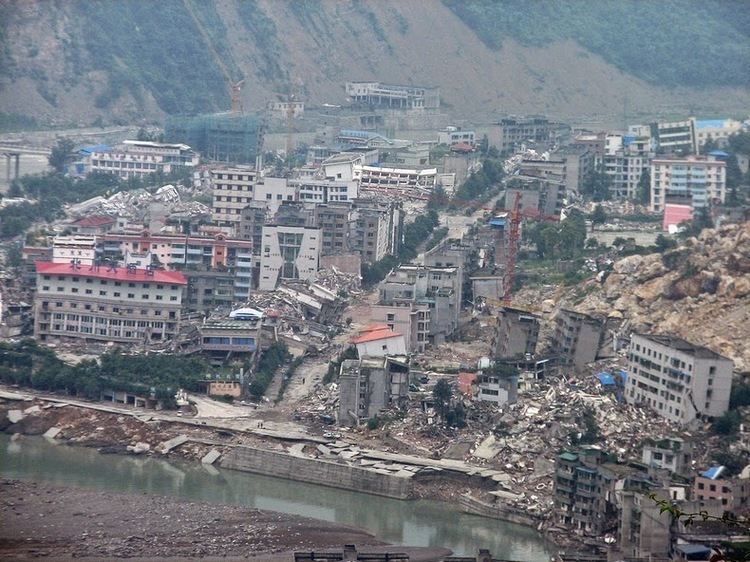Elevation 598 m (1,962 ft) Area 2,868 km² Area code 0816 | County seat Yongchang (永昌镇) | |
 | ||
Country People's Republic of China Towns & Townships ListTownsQushan (曲山镇)Leigu (擂鼓镇)Tongkou (通口镇) TownshipsXiangquan (香泉乡)Chenjiaba (陈家坝乡)Guixi (桂溪乡)Guanling (贯岭乡)Yuli (禹里乡)Xuanping (漩坪乡)Baini (白坭乡)Xiaoba (小坝乡)Piankou (片口乡)Kaiping (开坪乡)Badi (坝底乡)Baishi (白什乡)Qingpian (青片乡)Duba (都坝乡)Taolong Tibetan Township (桃龙藏族乡)Dunshang (墩上乡)Macao (马槽乡) Points of interest Yaowang Valley (Southeast Gate) | ||
Rebuilding beichuan china
Beichuan Qiang Autonomous County (simplified Chinese: 北川羌族自治县; traditional Chinese: 北川羌族自治縣; pinyin: Běichuān Qiāngzú Zìzhì Xiàn; Qiang: Juda Rrmea nyujugvexueaji xae) is a county under the jurisdiction of Mianyang City in northern Sichuan province, China. It is located in an ethnically diverse mountainous region of Sichuan. Its Chinese name literally means "North" (bei) "River" (chuan). Its new county seat is located at Yongchang Town after the 2008 Sichuan earthquake.
Contents
- Rebuilding beichuan china
- Map of Beichuan Mianyang Sichuan China
- Beichuan earthquake
- Geography Demographics
- History and culture
- Claim to Yu the Great
- Great Sichuan Earthquake
- Administrative divisions
- Education
- References
Map of Beichuan, Mianyang, Sichuan, China
Beichuan earthquake
Geography & Demographics
It has an area of 2,867.83 square kilometres (1,107.28 sq mi) and a population of 160,156 in 2006, 56.7% of which are Qiang people, a Sino-Tibetan people related to Tibetans, and 40.1% of which are Han Chinese.
History and culture
The first administrative county of Beichuan was set up in 566 A.D. during the Northern Zhou dynasty. The Tang dynasty first created another county, Shiquan (Chinese: 石泉; pinyin: Shíquán) inside the original Beichuan county in 634 A.D., then in 651 A.D. merged Beichuan county into Shiquan. The Republic of China changed the county name back to Beichuan in 1914 because there had been a Shiquan county in Shaanxi province before 566 A.D.
In 1988, the China granted Beichuan county the status of Qiang autonomy. The Beichuan Qiang Autonomous County was formally created in 2003.
Claim to Yu the Great
Beichuan was the first county in Sichuan to make the claim as the birthplace of Yu the Great, founder of the Xia dynasty and traditionally regarded as the first hereditary sovereign in Chinese history. Although this claim is probably more commercial than historical, Beichuan was part of West Qiang (Chinese: 西羌) that some ancient records accredited as Yu's birthplace, just like the other three locations in Sichuan, namely Wenchuan, Dujiangyan, and Shifang, that raised similar claims. Many places in other parts of China have made similar claims.
Great Sichuan Earthquake
Also like the other three counties and towns in Sichuan holding claims to be the birthplace of Yu the Great, Beichuan is among the most severely hit of all disaster regions following the 2008 Sichuan earthquake, including the Beichuan High School campus, where more than 1,000 students lost their lives after two main buildings collapsed. Beichuan's Party and government building also collapsed, and Yang Zesen, Beichuan's vice mayor then was among the victims. 80% of the county's buildings are said to have collapsed.
The county town, which prior to the earthquake had a population of 20,000, is to be made into a memorial park, as the site has been deemed too vulnerable. The survivors of the quake have been relocated.
The earthquake also caused a landslide on Mount Tangjia which dammed the Jian River and created the Tangjiashan Quake Lake. The lake was once in danger of causing the Tangjiashan Dam to collapse and catastrophically flood downstream communities, totalling over a million persons. On June 10, 2008, the lake spilled through an artificially constructed sluice channel and flooded the evacuated town. No casualties were caused.
Beichuan was at the center of one of two zones where seismic intensity were the highest at XI liedu during this earthquake and its aftershocks. Since the earthquake, the central government has increased fortification intensity for seismic design for the old county town from VI to VIII.
Administrative divisions
Beichuan County has 6 towns and 17 townships.
Education
Beichuan houses the Beichuan Red Army Elementary School.
